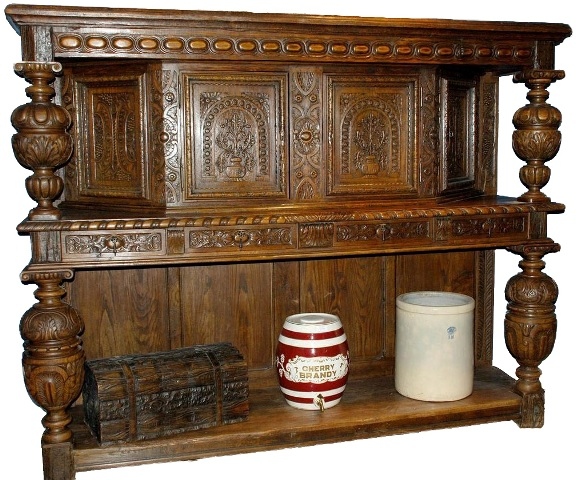Janus Slowikowski: ‘When is a cupboard not a cupboard’
Date published: 17 January 2016

Engllish Court Cupboard
Rochdale Antiques Society welcomed back Janus Slowikowski to speak on 'When is a cupboard not a cupboard'.
In medieval times a cupboard was literally a table (board) without doors, on which cups, plates, dishes and silver items were kept. It was meant for display and for serving drinks and snacks to visitors.
Originally, these cupboards were made out of planks of oak, but, even in the 15th century, oak was becoming scarce due to extensive ship and house building, so to save wood, instead of planking, they created a frame of oak and filled it in with a thinner wood slotted into grooves not nailed to the frame.
Cupboards with no vents were probably for clothes or bed linen and were sometimes known as armoires. When doors were added they were held with wooden pins called trenilles (or tree nails) and they had gothic styled carved holes for ventilation, with linen, possibly waxed, behind the vents to keep out vermin and insects
In 1632 a book was written describing an arc, or hutch, or house-shaped wooden box, to be hung from the bedroom ceiling to protect food from vermin and allow the occupants to snack overnight. Today, these are extremely rare and one had come up for auction recently and sold for £6,000.
Cup boards became more decorative and were known as a court cupboards from the French for short. They were a status symbol and the more shelves they had the higher the status: A king would have six shelves, dukes five shelves and downwards according to their status, but household ones probably only had two shelves. Another name for them was a buffet.
A dresser would also have a flat top for displaying food, the name coming from the French word ‘dresser’ – to arrange or display. It could have a pot board underneath for the heavy pots, shelving for plates, etc., and a small canopy over the top to protect the items from rainwater dripping down into the ancient buildings – a Welsh dresser is a prime example of this style.
By the 17th century the original court cupboard could have had a small enclosed cupboard fitted on to the flat board and later still this could have had a cupboard and press underneath. In this instance press comes from the old French ‘presser’ meaning to store things for a long time rather than just tidy them away.
Cupboards of all kinds were for a particular use not merely decorative. For example, a bacon-curing cupboard was tall enough to take sides of bacon and was placed near the fire to assist the curing and therefore often had a seat fitted to it for the occupant to sit by the fire.
Carpenters and then joiners made these cupboards, but they had to learn from continental cabinet makers how to make drawers using dovetail joints for the fronts of them. Cupboards with drawers were called withdrawing cupboards hence the word “drawers”. They also used the term cupboard of boxes when there were just drawers and a lot of them. The large, deep drawered cupboards were for scrolls and documents, but if they were very small they would be for spices and dried herbs.
A merchant would have a counter on the top of his board and the small drawers inside the cupboard were called tills, hence our shop terminology.
Tallboys get their name from old French, i.e. bois, meaning wood.
Commode in French means 'useful' and originally a commode was just a table, but it became a highly-decorative chest of drawers to be used in the drawing room.
A chiffonier again comes from the French. Their doors usually have fabric behind a grill referred to in French as chiffon and it is believed this resulted in the name for this type of furniture.
Mr Slowikowski illustrated his talk with superb photos of each type of furniture and we were all enthralled with them and their history.
The next meeting of the society will be on Wednesday 10 February at 7.30 in St Vincent’s Hall, Caldershaw Road, Norden, when Harry Frost, from Royal Worcester Porcelain, will describe items of this exquisite porcelain held in Royal collections.
Do you have a story for us?
Let us know by emailing news@rochdaleonline.co.uk
All contact will be treated in confidence.
Most Viewed News Stories
- 1Contractor appointed for regeneration scheme in Rochdale town centre
- 2'Eyesore’ land in the town centre will become home to new apartment block
- 3Rochdale Exchange Market to reopen after a decade
- 4Decision delayed on 445-home estate in Castleton
- 5Rochdale’s Fabdance Centre triumphs at national championships
To contact the Rochdale Online news desk, email news@rochdaleonline.co.uk or visit our news submission page.
To get the latest news on your desktop or mobile, follow Rochdale Online on Twitter and Facebook.

